Introduction
UF/IFAS Extension faculty and state specialists involved in the UF/IFAS South Florida Beef-Forage Program (SFBFP), in conjunction with the UF/IFAS Program Evaluation and Organizational Development unit, created a survey in 1982 that is used to evaluate ranch management practices. The survey is updated and distributed every five years to ranchers in 14 south Florida counties: Charlotte, Collier, DeSoto, Glades, Hardee, Hendry, Highlands, Hillsborough, Lee, Manatee, Martin, Okeechobee, Polk, and Sarasota.
There were 102 anonymous responses in 2011.
Characteristics of Beef Operations in South Florida
Type of Beef Operations: The beef cattle industry in south Florida is primarily commercial. A small percentage of ranchers ran both purebred and commercial herds (Figure 1).

Credit: UF/IFAS
Business Structure of the Ranch: Forty-three percent of ranches were family-owned, and thirty-seven percent were individually owned. Twenty-five percent were corporate owned, and ten percent operated as a partnership. (Some respondents operated in multiple business structures.)
Rancher’s Source of Income: Seventy-five percent of ranchers received income from another profession.
Years in Cattle Business: Survey respondents have been in the business for an average of 40 years.
Plans for the Next Five Years: Ninety-seven percent of ranchers planned to maintain or increase the size of their operations by 2016 (Figure 2).
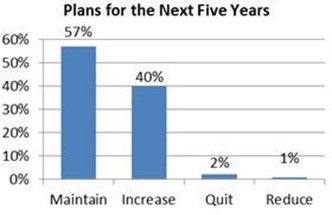
Credit: UF/IFAS
Reproduction
Pregnancy Rates: Average pregnancy rates are shown in Figure 3.
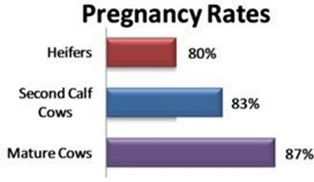
Credit: UF/IFAS
Pregnancy Checking: Fifty-two percent of ranchers checked for pregnancy. Veterinarians (67%) checked for pregnancy most often, followed by ranch employees (44%). Rectal palpation (88%) was the most commonly used method, followed by ultrasound (29%) and blood testing (4%). (Some respondents used multiple methods and received assistance from employees and veterinarians.) Forty-four percent of respondents attended a reproductive management (palpation) school.
Breeding Season: Sixty-three percent of ranchers used a controlled breeding season, whereas 37% exposed females to bulls year-round.
Weaning Rates: The weaning rate for heifers was 78%. The cow weaning rate was 77%.
Calf Loss: Calf loss was estimated at 4% gestational loss, 3% loss to predators, and 2% loss to disease.
Artificial Insemination: Sixteen percent of the ranchers who participated in the survey reported that 14% of their herd received artificial insemination. CIDR was the most commonly used method of synchronization, closely followed by prostaglandin.
Bull Breeds for Heifers: Angus bulls were most commonly used on heifers (Figure 4).
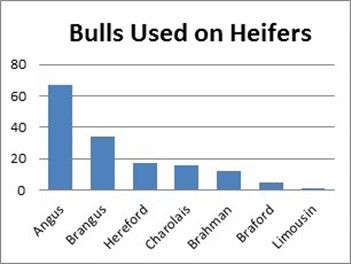
Credit: UF/IFAS
Bull Breeds for Cows: Angus and Brangus bulls were most frequently used on cows (Figure 5).
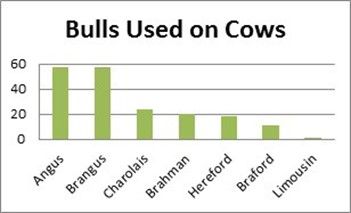
Credit: UF/IFAS
Bull to Heifer Ratio: On average, the bull to heifer ratio was one bull to 19 heifers.
Bull to Cow Ratio: On average, the bull to cow ratio was one bull to 23 cows.
Culled Cows: South Florida ranchers, on average, culled 8% of their cow herd each year.
Limitations to Reproduction: Producers ranked nutrition as the most significant limiting factor to reproduction, followed by management and reproductive disease.
Bull Selection: Surveyors ranked 12 attributes they used to select bulls. Weaning weight was the most important attribute, followed by expected progeny differences (EPD). The bull price was ranked third.
Heifer Management: Fifty-three percent of ranchers did not expose heifers to bulls before the mature cow herd. Seventy-six percent of operations managed their herd replacements separately from the mature cow herd.
Semen Testing: Figure 6 below indicates how often semen testing occurred for the bulls.
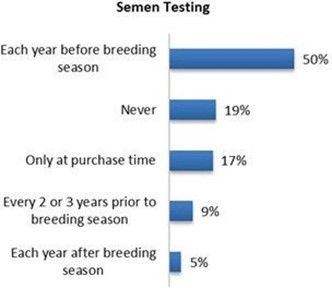
Credit: UF/IFAS
Trichomoniasis Testing: Forty-three percent of ranchers tested the herd for trichomoniasis.
Production
Cow or Calf Identification: Fifty-four percent of respondents identified each cow and 35% of respondents identified each calf with an ear tag, hot iron, or freezing brand.
Beef Herd Records: Sixty-six percent of ranchers used written herd records with 64% utilizing the records for business analysis and 43% using the records to select heifers and/or cull cows. Fifty-six percent of those keeping records were using a computerized system.
Annual Cow Cost: Ranchers estimated their cost per cow per year to be $246.
Age at Which Heifers First Calve: Sixty-seven percent of ranchers allowed their heifers to have their first calf at two years of age.
Herd Replacements: Ninety-three percent of ranchers raised their own heifers. Of those who purchased their heifers, 84% preferred buying directly from reputable sellers. Other sales and the FCA Heifer Sale were the next most preferred means of obtaining herd replacements. (Figure 7).
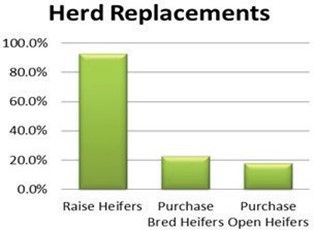
Credit: UF/IFAS
Marketing
Weaning Age and Weight: Calves were weaned at an average age of 7.3 months. Steer calves averaged 480 pounds and heifer calves averaged 459 pounds.
Calf Marketing Methods: Seventy-six percent of beef cattle operations sold their calves through the auction market. Many ranchers indicated multiple methods for marketing (Figure 8).

Credit: UF/IFAS
Marketing Preparation: Eighty-nine percent of the producers castrated calves before marketing (Figure 9).
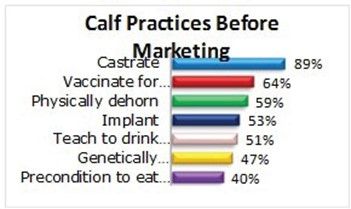
Credit: UF/IFAS
Herd Health
Control of External Parasites: Ninety-eight percent of producers controlled external parasites on their cattle.
External Parasite Control Methods: The pour-on method was the most commonly used among producers in south Florida. Dust bags were the least common method. Producers frequently used more than one method to control external parasites (Figure 10).
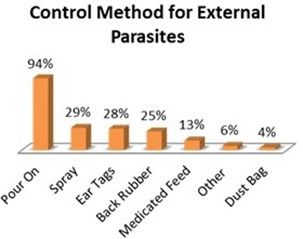
Credit: UF/IFAS
Liver Fluke Treatment: Survey results indicated 83% of the producers in south Florida treated the herd for liver flukes.
Internal Parasite Control Methods: Pour-on and injectable methods were most frequently used. Mineral and feed methods were used the least (Figure 11).
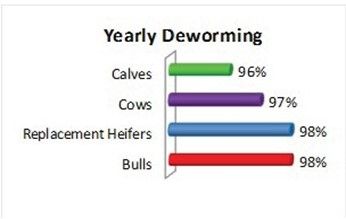
Credit: UF/IFAS
Vaccination Program: Many south Florida producers vaccinated their cow herd (Figure 12).
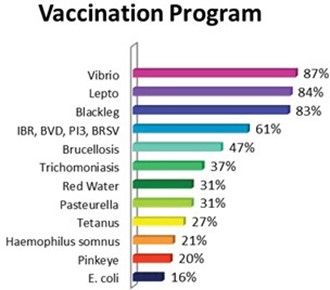
Credit: UF/IFAS
Nutrition
Body Condition Score Before Supplementing: Eighty-one percent of ranchers assessed cows’ body condition score (BCS) to determine when to begin and end supplementation. Eighty-two percent utilized BCS to determine the amount of supplement to feed to the animals. Many producers began supplementing in November (34%) and ended in April (35%).
Mineral Supplementation: Ninety-nine percent of producers provided mineral supplementation to their cattle. Ninety-one percent of the producers provided mineral supplements all year.
Pasture Analysis: Only 30% of ranchers reported analyzing their pasture grass for forage quality.
Sources of Winter Supplementation: Operations frequently used more than one form of supplement. Sixty-seven percent of the producers used molasses as a protein supplement during the winter months (Figure 13).
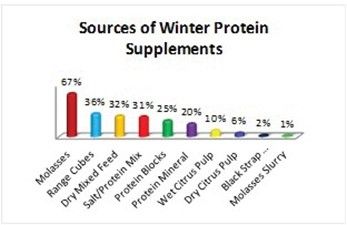
Credit: UF/IFAS
Winter Forages Used: Native range and hay were used by 64% of the producers in south Florida as a winter forage source. Thirty-eight percent used stockpiled forage (Figure 14).
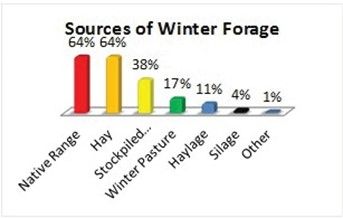
Credit: UF/IFAS
Hay Analysis: Only 35% of south Florida ranchers reported analyzing their hay or silage for forage quality.
Forage Production
Pasture and Hay Acreage: Survey responses represented at least 437,974 acres of pasture and 6,030 acres of hay production. Eighty-three percent of the acreage was owned. Thirty-four percent was leased at an average of $13 per acre per year.
Types of Grazing: Improved pasture and native range were the most commonly grazed acreage, followed closely by semi-improved pasture.
Lime/Fertilizer Application: Sixty percent of the respondents limed their pasture and hay fields. Sixty-six percent applied fertilizer.
Types of Forage: Bahiagrass was the most commonly used forage (Figure 15).

Credit: UF/IFAS
Types of Legumes: Producers identified Aeschynomene americana as the most commonly used legume (Figure 16).
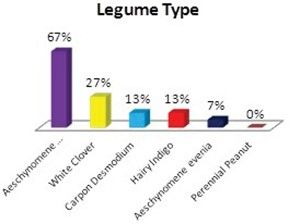
Credit: UF/IFAS
Hay Production: Thirty-one percent of respondents produced hay and 23% irrigated their hay fields.
Silage or Haylage Production: Six percent of survey respondents produced silage or haylage.
Stockpiled Limpograss: Seventeen percent of survey respondents stockpiled limpograss forage.
Rotational Grazing: Eighty-four percent of producers used rotational grazing in their pastures. Eighteen percent of those producers irrigated.
Mole Cricket Pasture Damage: Forty percent of producers reported damage from mole crickets. Sixteen percent of those producers applied nematodes for control and observed pasture improvement.
Organic Waste: Eight percent of ranchers used some type of organic waste on their pastures (sludge, biosolids, poultry litter, etc.) as fertilizer. Ranchers noticed an increase in weed production by 100% when sludge was applied. Seventy-five percent of those producers observed dying grass.
Troublesome Weeds: Producers ranked ten troublesome weeds. Dogfennel ranked as the most troublesome, followed by tropical soda apple (TSA) and smutgrass.
Weed Control Methods: Mowing or chopping is most commonly employed to combat weeds (Figure 17).
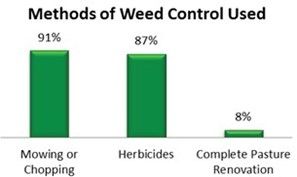
Credit: UF/IFAS
Additional Information
UF/IFAS Extension: Ninety-six percent of the producers reported that the service of UF/IFAS Extension to Florida’s beef industry was satisfactory.
Information Sources: Seventy-seven percent of the producers obtained information on beef production and/or management practices from other cattlemen (Figure 18).

Credit: UF/IFAS
Environment
Open Water Areas: Seventy-six percent of producers had open water areas on their property. Ninety-three percent of those producers gave their cattle access to the open water areas. Many of the producers (75%) did not fence off open water areas.
Water Troughs: Approximately 75% of producers with accessible open water areas provided water troughs.
Feeding around Open Water Sources: Eighty-seven percent of survey respondents did not feed minerals, hay, or supplements to their animals within 200 feet of open water areas.
Water Quality Manual: Seventy-nine percent of ranchers utilized the “Water Quality Best Management Practices for Florida Cow/Calf Operations” manual (FDACS 2008).
Problems Facing the Cattle Industry: South Florida cattle producers ranked nine considerations that were used to assess problems facing the beef cattle industry. Environmental issues and governmental regulations were ranked as the most important, followed by animal welfare issues and consumer concerns.
Reference
Florida Department of Agriculture and Consumer Services. 2008. “Water Quality Best Management Practices for Florida Cow/Calf Operations.” Office of Agricultural Water Policy, DACS-P-01280. Accessed on October 5, 2016. http://freshfromflorida.s3.amazonaws.com/Bmp_FloridaCowCalf2008.pdf